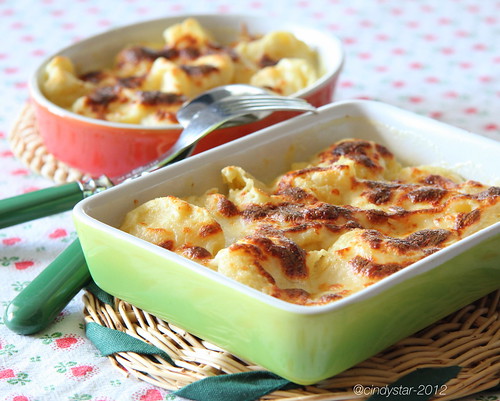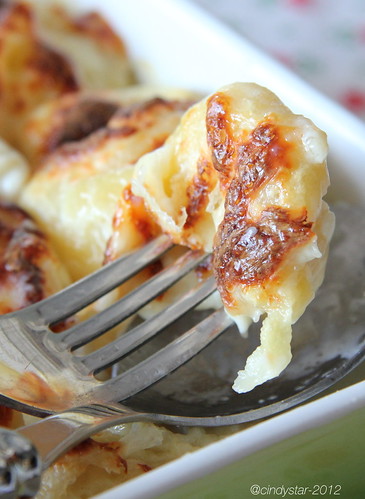Chnéf-fléne Walser per l'Abbecedario Culinario e WHB # 322
E' la volta di una ricettina salata per la Valle d'Aosta, la prima regione, capitanata dalla simpatica Gata da plar, ad inaugurare il nuovo Abbecedario Culinario organizzato dall'intraprendente Trattoria MuVarA.
Per chi avesse voglia di partecipare con una ricetta valdostana, c'è tempo ancora fino a domani alla mezzanotte, per ogni ulteriore info sul regolamento vi rimando all'annuncio personale di Gata.
Ricettina dal titolo strano, ma dagli ingredienti semplici e di casa e di facile esecuzione.
Gli Chnéf-fléne (sinonimo dialettale per bottoni) altro non sono che degli gnocchetti fatti di latte, farina e uova, poi conditi con burro fuso o fonduta di Fontina. E' una specialità della popolazione Walser, di origini germaniche, che si stabilì in Valle d'Aosta ancora in epoca medioevale.
Altre dettagliate informazioni sulla cucina valdostana e sulla storia di questa regione qui.
Altre dettagliate informazioni sulla cucina valdostana e sulla storia di questa regione qui.
Per 3/4 persone:
- 250/300 g di farina
- 250/300 ml di latte
- 1 uovo
- sale
Mescolare le uova con la farina e il latte, aggiungere un pizzico di sale ed amalgamare bene fino ad ottenere una pastella omogenea. Fare riposare per 30 minuti.
Mettere a bollire abbondante acqua salata e con l'aiuto di un cucchiaio colare piccole quantità di pastella. Quando le palline che si formano riemergono in superficie, scolarle e disporle in una pirofila leggermente imburrata. Condire con burro fuso in cui è stata fatta appassire una cipolla e parmigiano oppure con fonduta di fontina e far gratinare in forno qualche minuto sotto al grill.
Per fare la fonduta: mettere ad ammorbidire la fontina a pezzettini nel latte per un paio di ore, poi sciogliere il tutto a fuoco dolce finchè ben cremoso, a piacere aggiungere un tuorlo d'uovo. Anche se la fonduta tende a rapprendersi in fretta poi in forno si riscioglierà e gratinerà bene.
Chnéf-fléne Walser
Chnéf-fléne (literally buttons), are a sort of gnocchi, little dumplings made with a mix of flour, milk and eggs, typically served with melted butter or cheese fondue.
They are a speciality of a Northern Italian region, Valle d'Aosta.
Serving 3/4:
They are a speciality of a Northern Italian region, Valle d'Aosta.
Serving 3/4:
- 250/300 g all-purpose flour
- 250/300 ml milk
- 1 egg
- salt
Take to a boil abundant salted water and helping with a spoon pour into small amounts of batter. When the dough balls come up to the surface, drain and lay on a baking dish, lightly buttered. Drizzle with melted butter (but first fry/sautée a little diced onion in it) and grated parmesan or with some cheese fondue and grill in the oven a few minutes.
For the fondue: let soak diced cheese (better if you use Fontina or something similar) in some milk for a couple of hours, then melt it all on low heat until very creamy, then add an egg yolk at your pleasure. Don't bother if the fondue will thicken quickly, just spread over the dumplings (with the liquid too) and it will melt again and perfectly bake in the oven.
Some information about Valle d'Aosta from Wikipedia:
It is a small mountainous region in North-Western Italy, bordered by Rhône-Alpes, France to the west, Valais, Switzerland to the north and the region of Piedmont to the south and east.
It is the smallest, least populous, and least densely populated region of Italy.
The native population speaks Valdôtain, a form of Franco-Provençal (Arpitan), as their first language, while in the Lys Valley there is a Walser German speaking minority. The regional capital is Aosta.
The cuisine of the Aosta Valley is characterized by simplicity and revolves around "robust" ingredients such as potatoes, polenta, and rice, cheese and meat and rye bread. Many of the dishes involve Fontina, a cheese with PDO status, made from cow's milk that originates from the valley. It is found in dishes such as a soup a la valpellinentse. Other typical local cheese are Toma and Robiola. Valle d'Aosta Fromadzo is produced locally since the 15th century and also has PDO status.
Regional specialties, besides Fontina, are mochetta (dried chamois meat, prepared like prosciutto), Vallée d'Aoste Lard d'Arnad (a cured and brined fatback product with PDO designation), Vallée d’Aoste Jambon de Bosses (a kind of ham, likewise with PDO designation), and a black bread. Notable wines include a white wine from Morgex, a red wine blend from Arvier (Enfer d'Arvier), and a Gamay.
Notable dishes include Carbonada, consisting of salt-cured beef cooked with onions and red wine served with polenta; breaded veal cutlets called costolette; tetouns, salt-cured cow's udder that is cooked and sliced; and bistecca a la valdostana, a steak with croutons and melted cheese.

This recipe is my personal entry to WHB # 322
hosted by Aitina, Branka and Conchita from Fragoliva.



















6 commenti:
ma quanto devono esser buoni 'sti bottoncini gnoccolosi???!!! :P*****
Grazie tantissimissimeeeeeeeeeeeeeee ^___________^
Bacione!
Cindy... ripasso... mi mandi la foto del piatto? serve per fare un bel collage di tutte le foto delle ricette ricevute! ^^
GIURO... non ne farò altro uso ;P
La foto invece dei Torcetti sono riuscita a prenderla, non era protetta...
mandala all'indirizzo mail che trovi sotto il mio profilo! Grazie bacioneeeeee
Te lo scrivo anche qui! Ora ci siamo tutte!!! Ho aggiornato la A: http://abcincucina.blogspot.com/2012/02/come-aosta.html!
Grazie per aver partecipato!
Aiuolik
Grazie a te, Mony, una bellisima inaugurazione la tua raccolta! Credo che x la foto non ci sia più problema perchè la vedo nel collage, scusa ma mi era scappato il tuo secondo commento :-(
Elo, grazie a te per la raccolta! :-)
Avanti con la B!
Now these make me really curious. They sound a bit like German 'Spaetzle' just somewhat grown out of size :)
Thanks for the recipe and the information (you could have added a sound file though with the pronunciation of Chnéf fléne *hihi*)
Torwen, they could be ... giant Spaetzle :-))
To tell you the truth, it's an unpronounceable name for me too! :-))
Posta un commento
grazie della visita e gentilmente firma sempre i tuoi commenti!
thanks for passing by and please sign up your comments!